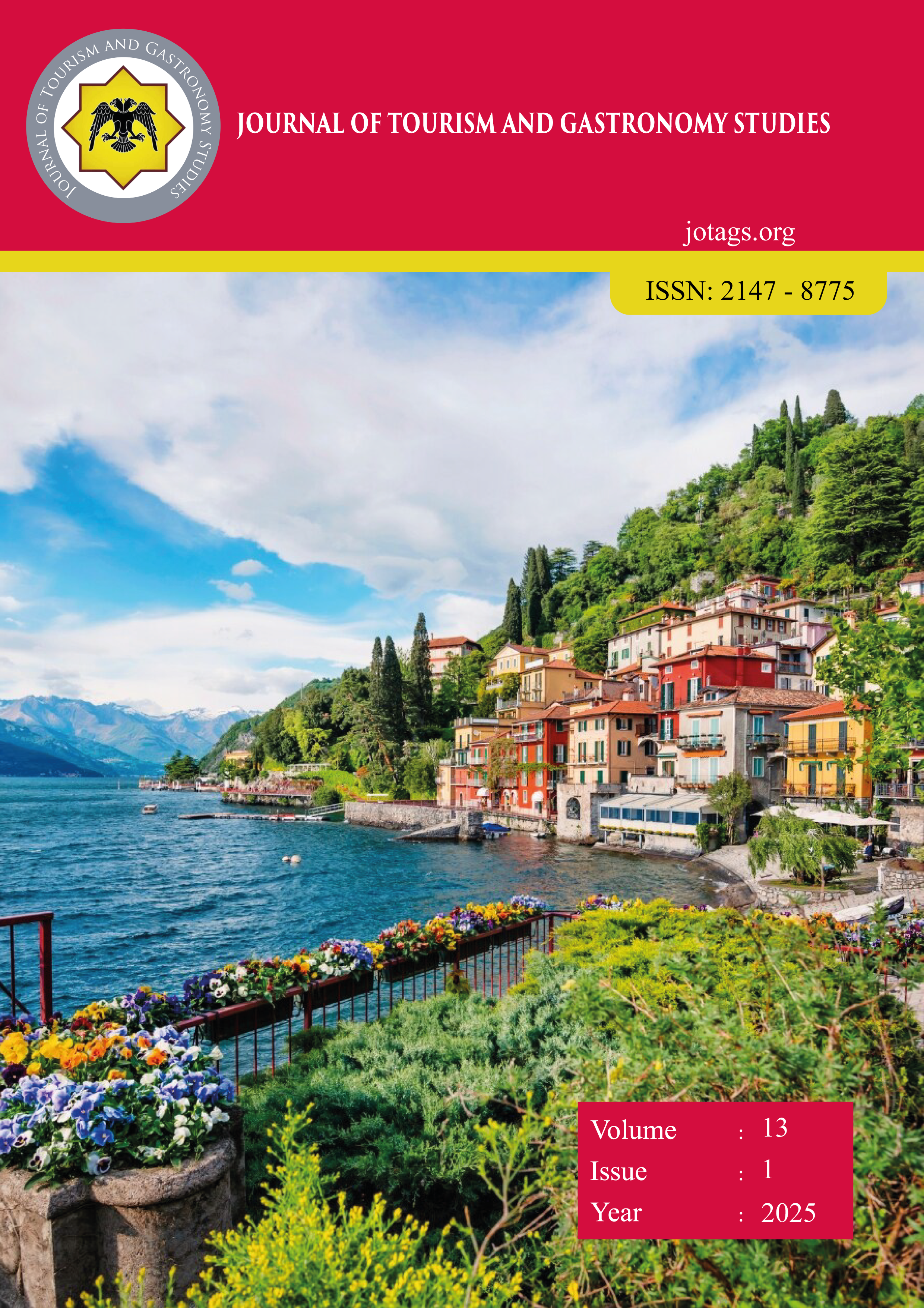Tarihi Bölgelerde Algılanan Kültürel Atmosferin Destinasyon Ziyaret Niyeti ve Destinasyon Bağlılığı Üzerindeki Etkisi: Olumlu Duyguların Aracı Rolü (The Effect of Perceived Cultural Atmosphere in Historical Sites on Destination Visit Intention and Destination Attachment: The Mediating Role of Positive Emotions)
DOI:
https://doi.org/10.21325/jotags.2025.1551Keywords:
Cultural atmosphere, Cultural heritage, Historical sites, Destination visit intentionAbstract
This research aims to understand the impact of cultural involvement, interaction with locals, traditional activities, and interior decoration on visit intention and destination attachment in historic districts. A total of 212 questionnaires were collected using the quantitative research method, specifically the survey technique. In the study, data was collected from tourists in Bodrum using a convenience sampling method. The collected data was analysed using the structural equation model in the Smart-PLS program. The results of the statistical analysis showed that cultural involvement, interaction with local people, traditional activities and interior decoration significantly and positively influence the development of positive emotions. It was also statistically revealed that positive emotions positively influence tourists' destination attachment and visit intention. Moreover, positive emotion was found to mediate the relationship between cultural involvement, traditional activities and interior design and destination attachment and visit intention. In addition, this research has provided theoretical and practical contributions.
References
Adam, I., Adongo, C. A., & Amuquandoh, F. E. (2019). A structural decompositional analysis of eco-visitors’ motivations, satisfaction and post-purchase behaviour. Journal of Ecotourism, 18(1), 60-81.
Agency, T. (2024). Tourism Statistics. Retrieved from https://www.tursab.org.tr/istatistikler
Anderson, B. (2009). Emotion, Space and Society. Affective Atmospheres, 2(2), 77-81.
Bitner, M. J. (1992). Servicescapes: The impact of physical surroundings on customers and employees. Journal of Marketing, 56(2), 57-71.
Boone Jr, H. N., & Boone, D. A. (2012). Analyzing likert data. The Journal of Extension, 50(2), 48.
Brislin, R. W. (1976). Comparative research methodology: Cross-cultural studies. International Journal of Psychology, 11(3), 215-229.
Brown, G., Smith, A., & Assaker, G. (2016). Revisiting the host city: An empirical examination of sport involvement, place attachment, event satisfaction and spectator intentions at the London Olympics. Tourism Management, 55, 160-172.
Chen, C.-F., & Tsai, D. (2007). How destination image and evaluative factors affect behavioral intentions? Tourism Management, 28(4), 1115-1122.
Croasmun, J. T., & Ostrom, L. (2011). Using likert-type scales in the social sciences. Journal of Adult Education, 40(1), 19-22.
Doganer, S. (2017). Architectural design studio on sustainable tourism alternatives in the San Antonio Missions Historic District. Tourism and Hospitality Research, 17(3), 298-313.
Fornell, C., & Larcker, D. F. (1981). Evaluating structural equation models with unobservable variables and measurement error. Journal of Marketing Research, 18(1), 39-50.
Fuller, C. M., Simmering, M. J., Atinc, G., Atinc, Y., & Babin, B. J. (2016). Common methods variance detection in business research. Journal of Business Research, 69(8), 3192-3198.
Gao, J., Lin, S. S., & Zhang, C. (2020). Authenticity, involvement, and nostalgia: Understanding visitor satisfaction with an adaptive reuse heritage site in urban China. Journal of Destination Marketing & Management, 15, 100404.
Goulding, C. (2023). “Atmosphere”-the what? The where? And the how?: Launching the annals of tourism research curated collection on atmosphere 2023. Annals of Tourism Research, 101, 103591.
Habib, M. D., & Qayyum, A. (2018). Cognitive emotion theory and emotion-action tendency in online impulsive buying behavior. Journal of Management Sciences, 5(1), 86-99.
Hair, J., Anderson, R., Babin, B., & Black, W. (2010). Multivariate data analysis: A global perspective (Vol. 7): Pearson Upper Saddle River. In: NJ.
Hair Jr, J. F., Hult, G. T. M., Ringle, C., & Sarstedt, M. (2016). A Primer on Partial Least Squares Structural Equation Modeling (PLS-SEM): Sage publications.
He, Z., Jingru, W., & Xiyue, Z. (2019). Comprehensive assessment of sustainable tourism-oriented revitalization in a historic district: A case study of Qianmen Area, Beijing, China. Journal of Resources and Ecology, 10(5), 559-568.
Heide, M., & GrØnhaug, K. (2006). Atmosphere: Conceptual issues and implications for hospitality management. Scandinavian Journal of Hospitality And Tourism, 6(4), 271-286.
Holmstrom, A. J., & Burleson, B. R. (2011). An initial test of a cognitive-emotional theory of esteem support messages. Communication Research, 38(3), 326-355.
Huiyan, H., & Min, W. (2019). The spatial perception of micro-transformation in historic district based on visual methodology. World Regional Studies, 28(4), 189.
Jiang, S., Ma, H., Yang, L., & Luo, S. (2023). The influence of perceived physical and aesthetic quality of rural settlements on tourists’ preferences—a case study of zhaoxing dong village. Land, 12(8), 1542.
Jiang Ting, J. T., & Zhang Feng, Z. F. (2013). Influence of tourist-to-tourist interaction on re-patronage intention: A tourist experience perspective.
Khan, M. J., Chelliah, S., & Ahmed, S. (2017). Factors influencing destination image and visit intention among young women travellers: role of travel motivation, perceived risks, and travel constraints. Asia Pacific Journal of Tourism Research, 22(11), 1139-1155.
Kim, H. S., & Choi, B. (2016). The effects of three customer-to-customer interaction quality types on customer experience quality and citizenship behavior in mass service settings. Journal of Services Marketing, 30(4), 384-397.
Kock, N. (2015). Common method bias in PLS-SEM: A full collinearity assessment approach. International Journal of e-Collaboration (ijec), 11(4), 1-10.
Kotler, P. (1973). Atmospherics as a marketing tool. Journal of Retailing, 49(4), 48-64.
Kroeber, A. L. (1952). Culture: A Critical Review of Concepts and Definitions. Peabody Museum.
Kucukergin, K. G., Kucukergin, F. N., & Dedeoglu, B. B. (2020). An overview of the destination physical servicescape with SOR paradigm: The importance of prestige sensitivity. Asia Pacific Journal of Tourism Research, 25(5), 473-488.
Lam, J. F., Ong, C.-E., Wu, T., He, R., & Li, S. (2022). The right to entrepreneurial expression over heritage significance: The micropolitics of an adapted cafe in a historic Chinese town. Built Heritage, 6(1), 26.
Liao, C., & Ming, Q. . (2015). Tourism development and urban historic street reservation. Urban Problems, 2015(4), 17–22. . doi:https://doi.org/10.13239/j.bjsshkxy.cswt.150403
Lin, H., Zhang, M., Gursoy, D., & Fu, X. (2019). Impact of tourist-to-tourist interaction on tourism experience: The mediating role of cohesion and intimacy. Annals of Tourism Research, 76, 153-167.
Lin, R., & Utz, S. (2015). The emotional responses of browsing Facebook: Happiness, envy, and the role of tie strength. Computers in Human Behavior, 52, 29-38.
Lin, Z., & Wong, I. A. (2020). Cocreation of the hospitality brand experience: A triadic interaction model. Journal of Vacation Marketing, 26(4), 412-426.
Lu, L., Chi, C. G., & Liu, Y. (2015). Authenticity, involvement, and image: Evaluating tourist experiences at historic districts. Tourism Management, 50, 85-96.
Martínez-Sierra, G., Arellano-García, Y., & Hernández-Moreno, A. (2022). Which situations trigger emotions of secondary school mathematics teachers? International Journal of Science and Mathematics Education, 20(3), 575-595.
McCain, G., & Ray, N. M. (2003). Legacy tourism: The search for personal meaning in heritage travel. Tourism Management, 24(6), 713-717.
Molinillo, S., Japutra, A., & Ekinci, Y. (2022). Building brand credibility: The role of involvement, identification, reputation and attachment. Journal of Retailing and Consumer Services, 64, 102819.
Mowen, A. J., Graefe, A. R., & Virden, R. J. (1998). A typology of place attachment and activity involvement. Paper presented at the Proceedings of the 1997 Northeastern Recreation Research Symposium.
Ning Wang, N. W. (1999). Rethinking authenticity in tourism experience.
Paiva, D. (2023). The paradox of atmosphere: Tourism, heritage, and urban liveability. Annals of Tourism Research, 101, 103600.
Pallasmaa, J. (2014). Space, place and atmosphere. Emotion and peripherical perception in architectural experience. Lebenswelt. Aesthetics and Philosophy of Experience.(4).
Podsakoff, P. M., MacKenzie, S. B., Lee, J.-Y., & Podsakoff, N. P. (2003). Common method biases in behavioral research: a critical review of the literature and recommended remedies. Journal of Applied Psychology, 88(5), 879.
Pourzakarya, M., & Bahramjerdi, S. F. N. (2019). Towards developing a cultural and creative quarter: Culture-led regeneration of the historical district of Rasht Great Bazaar, Iran. Land Use Policy, 89, 104218.
Prayag, G., & Ryan, C. (2012). Antecedents of tourists’ loyalty to Mauritius: The role and influence of destination image, place attachment, personal involvement, and satisfaction. Journal of Travel Research, 51(3), 342-356.
Qian, Z. (2021). World Heritage Site inscription and waterfront heritage conservation: evidence from the Grand Canal historic districts in Hangzhou, China. Journal of Heritage Tourism, 16(6), 684-704.
Ram, Y., Björk, P., & Weidenfeld, A. (2016). Authenticity and place attachment of major visitor attractions. Tourism Management, 52, 110-122.
Revilla, M. A., Saris, W. E., & Krosnick, J. A. (2014). Choosing the number of categories in agree–disagree scales. Sociological Methods & Research, 43(1), 73-97.
Sarstedt, M., Ringle, C. M., & Hair, J. F. (2017). Partial least squares structural equation modeling. Handbook of Market Research, 26(1), 1-40.
Shafaei, F. (2017). The relationship between involvement with travelling to Islamic destinations and Islamic brand equity: a case of Muslim tourists in Malaysia. Asia Pacific Journal of Tourism Research, 22(3), 255-271.
Sharma, P., & Nayak, J. K. (2018). RETRACTED: Testing the role of tourists' emotional experiences in predicting destination image, satisfaction, and behavioral intentions: A case of wellness tourism. Tourism Management Perspectives, 28, 41-52.
Silva, K. D. (2015). The spirit of place of Bhaktapur, Nepal. International Journal of Heritage Studies, 21(8), 820-841.
Sumartojo, S., & Pink, S. (2018). Atmospheres and The Experiential World: Theory and Methods: Routledge.
Tieskens, K. F., Schulp, C. J., Levers, C., Lieskovský, J., Kuemmerle, T., Plieninger, T., & Verburg, P. H. (2017). Characterizing European cultural landscapes: Accounting for structure, management intensity and value of agricultural and forest landscapes. Land Use Policy, 62, 29-39.
Vecco, M. (2020). Genius loci as a meta-concept. Journal of Cultural Heritage, 41, 225-231.
Verhagen, T., & Van Dolen, W. (2011). The influence of online store beliefs on consumer online impulse buying: A model and empirical application. Information & Management, 48(8), 320-327.
Vong, T.-N., Lai, K., & Li, Y. (2016). Sense of place: Affective link missing between casino impact perception and support for casino development? Asia Pacific Journal of Tourism Research, 21(sup1), S76-S100.
Wang, X., Zeng, X., & Zhang, C. (2020). Cultural atmosphere production and tourist experience of antique commercial district: An exploratory study based on Xibulao street in Zhangjiajie. Tourism Science, 34(4), 46-55.
Whang, H., Yong, S., & Ko, E. (2016). Pop culture, destination images, and visit intentions: Theory and research on travel motivations of Chinese and Russian tourists. Journal of Business Research, 69(2), 631-641.
Yang, Y., Zhou, X., Fan, L., Yin, H., & Qu, H. (2023). Effects of perceived placeness on tourists’ authenticity experience via the mediating role of flow experience. Journal of Hospitality & Tourism Research, 47(7), 1091-1114.
Yi, X., Fu, X., So, K. K. F., & Zheng, C. (2023). Perceived authenticity and place attachment: new findings from Chinese world heritage sites. Journal of Hospitality & Tourism Research, 47(5), 800-826.
Zeithaml, V. A., Berry, L. L., & Parasuraman, A. (1996). The behavioral consequences of service quality. Journal of Marketing, 60(2), 31-46.
Zeng, X., Zhang, C., & Xu, D. (2024a). Developing and validating a scale to measure perceived cultural atmosphere in historic districts. Asia Pacific Journal of Tourism Research, 1-18.
Zeng, X., Zhang, C., & Xu, D. (2024b). Developing and validating a scale to measure perceived cultural atmosphere in historic districts. Asia Pacific Journal of Tourism Research, 29(9), 1152-1169.
Zhang, K., Deng, H., Wang, F., & Yuan, Y. (2023). Reproduction of consumer spaces and historic district touristification in Old Beijing City. Tourism Geographies, 25(2-3), 508-531.
Zhang, S., Xiong, K., Fei, G., Zhang, H., & Chen, Y. (2023). Aesthetic value protection and tourism development of the world natural heritage sites: a literature review and implications for the world heritage karst sites. Heritage Science, 11(1), 30.
Zhou, G., Liu, Y., Hu, J., & Cao, X. (2023). The effect of tourist-to-tourist interaction on tourists' behavior: The mediating effects of positive emotions and memorable tourism experiences. Journal of Hospitality and Tourism Management, 55, 161-168.
Zong, Y., Chen, J. S., & Tsaur, S.-H. (2023). Destination experiencescape for Hanfu tourism: Scale development and validation. Journal of Vacation Marketing, 13567667231200905.
Downloads
Published
How to Cite
Issue
Section
License
Copyright (c) 2025 Journal of Tourism & Gastronomy Studies

This work is licensed under a Creative Commons Attribution-NonCommercial 4.0 International License.








